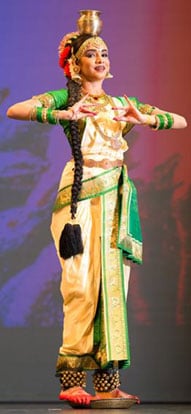The name Kuchipudi denotes both the dance style that has come to prominence since the 50s and the tiny, remote village where it was born- Kuchipudi.
In accordance with the imperative of classical dance, Kuchipudi is evenly balanced between the three aspects of dance: Nritta, Nritya and Natya without one element overshadowing another. Each and every Kuchipudi performance is illustrative of this fact. The Jathis or rhythmic sequences punctuating or concluding a verse or song are nritta. The Shabdams in which an interpretative line alternates with a rhythmic passage are nritya, while the dance dramas depicting a continuous story with a number of characters are natya. This kind of complete and clear-cut classifications is not found in the other classical styles of India.
The four aspects of abhinaya, i.e., Angika, Vachika, Aharya and Satvika are also to be found in ample measure in Kuchipudi style. Vachika abhinaya is a special feature of the Kuchipudi style. The dancer not merely dance, but also acts with gestures as well as words. And towards this end he has o train his voice also in order to project it properly in the improvised theatres. As already mentioned, through training in music is part of the curriculum.
The Kuchipudi artiste should learn to sing with his voice, interpret the meaning of the song with his gestures, express the sentiments with face and eyes and echo the rhythm with his feet. Satvikabhinaya is also taught to the students with great care and diligence. While the eyes become the mirror of the soul, the face becomes a veritable playground of varied emotions which being natural and spontaneous evokes instant response from the audience.
The students are taught all the ‘Samyutha’ and ‘Asamyutha’ Hasthas, with the 108 Karanas, Charis, and mandalas-movements of head, neck, eyes and eyebrows, according to the Natya Sastra. The student has to learn the Natya and Nayika styles completely. Angika, Vachika, Satvika and Aharya- the four types of actions are essential. Moreover, the student must be able to sing and present the meaning by Hastha-Mudras; express bhaava through his eye and rhythm by means of his footwork. It takes at least 10 years for an ordinary student to master this art.
Kuchipudi dancers dance to the dance to the songs of Jayadeva’s Gita Govindam, to the Tarangams of Narayana Teertha and to the Padamas of Kshetrayya. Whenever a dancer performs the ‘Bala Gopala Tarangam’ he executes his steps with a pot of water on the head, on the sharp edges of brass plate. he also dances on the spherical surface of an earthen pot while he thus performs. It can be concluded that Kuchipudi Natya combines speech, song, mime and dance; the themes Sabda, Muktayi and Daruvu. The songs rendered by the Kuchipudi artistes are padams, kritis and javalis, which are purely classical models for Abhinaya.Kuchipudi dance-dramas are ‘Sringara’ oriented. The fundamentals of Nritta, Nritya and Abhinaya are the same as those of Bharata Natyam.
